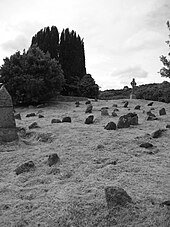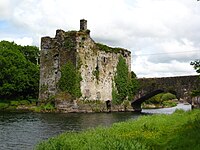Canovee
| Canovee | |
| County Cork | |
|---|---|
| Location | |
| Grid reference: | W412711 |
| Location: | 51°53’21"N, 8°51’19"W |
| Data | |
| Local Government | |
Canovee, also known as Cannaway is a village in the valley of the River Lee in County Cork.
The parish has sometimes been referred to as an island,[1] because most of the parish's boundaries are formed by bodies of water. For example, the River Lee constituting its north-eastern, northern and north-western borders, the Kame River and one of its tributaries lie to the east, and the Aghthying Stream is to the west.
History

13th and 14th centuries
Mac Carthaigh's Book (published in the 17th century) records that in 1262[sic], the Norman De Cogan castle of Magh Oiligh (Mahallagh) was destroyed by Fínghin Reanna Róin Mac Carthaigh, King of Desmond, and the people of Desmond. Finghín's forces defeated the Norman FitzGeralds of Munster at the Battle of Callan in 1261, curtailing Geraldine influence in Desmond.
The Annals of Inisfallen record that, in 1317, "warfare breaks out between some of the Cogans and the Barrys, and the lands of Dáuíd de Cócán from Loch Mu-Choba to Bern na hEile are laid waste and burned by the Barrys and some of the Roches. After Candlemas a further prey is taken by them against the same Cogans; and in the course of this raid J[ohn ?], son of Godfrey, is despoiled, his court being burned, and the castle of Mag Oilig (Mahallagh) is destroyed" (once again).[2]
17th century
The Civil Survey Of The Barony Of Muskerry in 1656,[1] a cadastral survey of landholdings in Ireland by the Cromwellian administration,[3] recorded 'Canavoy' Parish as consisting of:
ten Plowlands and an half' is said to be "mear'd & bounded on the East with the Parish of Aglish, and distinguish'd from it by a small Brook running into the River Lee, on the South with the Parish of Moviddy, on West with the Parish of Kilmurry, and on the North West, & North with the River Lee, the said Parish is in Length from Carrigadrohid on the North, to the little ford call'd Ahanaboy on the South two Miles & in Breadth from the Lands of Rooves on the East, to the Lands of Ballytrasny in the West one Mile & half.For the Generality of the Soyl it's Cold and Indifferent good for tillage, if Manur'd with Lyme or sea sand, which lyeth remote from it. Here are some Timber Wood & Coppices...
Here is the Parochial Church of the said Parish, standing about the bottom of the said Island of Canavoy near the River Lee. Nothing remains thereof but ye Walls, And on the North side near the same standeth the Walls of a large Ancient House, Which belongeth to the Chief Proprietor of the said Island, being the Famely of the Longs.

To the north in the neighbouring village of Carrigadrohid, the castle 'Situated on a rock in the midst of the River Lee' was valued at £100, the bridge across the Lee was made of timber and although out of repair, was passable on foot. There were six small houses and Cabbins and gardens- not valuable.
18th century
The Compleat Irish Traveller in 1788 reports:
At Mahallagh, five miles east from Macroomp, is a pleasant seat on the south bank of the Lee. Four miles east by south from Macroomp, in the parish of Canaboy, is a pleasant seat, graced with an handsome house, good gardens, large orchards, fish ponds, and a great number of trees planted. In the same parish is Shandangan, a mile south- west of the former, another pretty seat; the gardens lie to the west of the house, and are formed out of a drained bog, which is now cut into pleasant ponds; here are good orchards, and a deer park."[4]
19th century
Carlisle's Topographical Dictionary of Ireland in 1810 records:
Connoway, or Canaboy, in the Barony of Muskerry, Co. Cork is mentioned. It is described as having neither church, nor Glebe House. In 1806, the Vicar was one James Bentley Gordon, who resided in the Diocese of Ferns and 'occasional duties' were performed by a Curate residing in an adjoining parish 'at a salary of 10'.[5]
Gorton's Topographical Dictionary of Great Britain and Ireland in 1833 has:
The parish of Cannaway, or Canaboy, in the barony of Muskerry upon the River Lee in Co. Cork was named as one of the five Established Church parishes that constituted the Union of Killaspugmullane. The population was 1470 and the parish had an annual value of £230.[6]
References
- ↑ 1.0 1.1 "Civil Survey A.D. 1654-1656 County Waterford Vol VI with Appendices". http://www.corkpastandpresent.ie/history/batch1/civilsurveyx.
- ↑ "Annals of Inisfallen". http://www.ucc.ie/celt/published/T100004/.
- ↑ "Early Modern History - Civil and Down Surveys". History Ireland. 6 March 2013. http://www.historyireland.com/early-modern-history-1500-1700/civil-and-down-surveys/.
- ↑ "The compleat Irish traveller, Volume 2". 1788. https://books.google.com/books?id=VdsHAAAAQAAJ&q=mahallagh+castle&pg=PA64.
- ↑ Carlisle, Nicholas (1810). "A topographical dictionary of Ireland; exhibiting the names of the several cities, towns, parishes and villages, with the barony, county, and province, to which they respectively belong". https://archive.org/stream/topographicaldic00carluoft/topographicaldic00carluoft_djvu.txt.
- ↑ Gorton, John (1833). "A Topographical Dictionary of Great Britain and Ireland". https://books.google.com/books?id=-o9CAAAAYAAJ&q=canaboy+cork+muskerry&pg=PA360.
Books
- History of The City of Dublin, From The Earliest Accounts To The Present Time (1813) J. Warburton et al.[1] (In Appendix III (xxvii), amongst the parishes in Muskerry with "perfect [Down Survey] maps; not damaged by fire, &c" is Kanaboy)
- The County And City Of Cork Remembrancer; or, Annals Of The County And City Of Cork (1837) Francis. H. Tuckey.[2] (on page 63, there is mention of an inquisition in Cork on 4 November 1584, which- amongst other things- found that 'on the death of Matthew Sheyn, bishop of Ross, that see had three plowlands of Ballynaspick, the rent of Rochefort's land, the rent of Currickanaway of Ringaskiddy, Downaghmore, Aghabulloge and Canaboy)
- ↑ Warburton, John; Whitelaw, James; Walsh, Robert (1818). "History of the City of Dublin". https://books.google.com/books?id=GNc_AAAAcAAJ&q=kanaboy+cork&pg=PR28.
- ↑ "Full text of "The county and city of Cork remembrancer; or, Annals of the county and city of Cork"". Cork, O. Savage and son. 1837. https://archive.org/stream/countycityofcork00tuck/countycityofcork00tuck_djvu.txt.